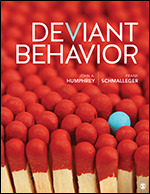Deviant Behavior
- John A. Humphrey - Saint Anselm College
- Frank Schmalleger - University of North Carolina, Pembroke
What makes behavior deviant, and who gets to decide what deviance is? Deviant Behavior seeks to answer these questions and more. This compelling new text covers the social forces that shape deviance, the motivations and consequences of deviant behaviors, and how our definition of deviance changes over time. Authors John A. Humphrey and Frank Schmalleger discuss a wide range of deviant behaviors—from criminal acts to extreme forms of everyday behavior—and provide students the necessary foundation to understand the impact of globalization on traditional and emerging forms of deviance. Readers will explore deviance in the modern world using a systematic application of social and criminological theories to a range of deviant behaviors to help them better understand themselves, others, and society.
Included with this title:
The password-protected Instructor Resource Site (formally known as SAGE Edge) offers access to all text-specific resources, including a test bank and editable, chapter-specific PowerPoint® slides. Learn more.
Supplements
edge.sagepub.com/humphrey
Online resources included with this text
The online resources for your text are available via the password-protected Instructor Resource Site, which offers access to all text-specific resources, including a test bank and editable, chapter-specific PowerPoint® slides.
“Humphrey and Schmalleger’s Deviant Behavior not only introduces students to what the essence of deviance is, it also inspires student curiosity about the structure, processes, and dynamics associated across a wide range of deviant forms, from high-consensus, violent forms of deviant behavior to lower-consensus extreme forms of everyday behaviors. Deviant Behavior presents a conceptual overview of the nature of deviance, complete with relevant theoretical explanations, and provides a survey of deviant behavior forms pertinent to a 21st-century experience.”
"This is a well-organized, comprehensive textbook that considers the role of social media and digital spaces. It has relevant, current examples that help illustrate the applicability of the material."
Deviant Behavior is a well-structured and presented view of the issue of deviance. Suitable for not only undergraduate students, but postgraduate learners as well. It provides a comprehensive look at nature of deviance along with relevant theoretical perspectives associated with different forms of deviance.
This was a very very difficult decision. This book is excellent in providing concrete examples to apply theory to. It also is excellent in ending the chapter with an overview of how the theories apply.
The HUGE gap is the omission of critical theories such as feminism, critical race, and intersectionality from the contemporary theory.
Because i value having concrete examples to apply theory to, I am chosing this book. However, I know I will be adding a great deal of content to the course to make up for the missing critical theories.
If I could have found a book with these excellent chapter applications AND critical theories included it would have been a no brainer.
Sample Materials & Chapters
Chapter 1: Introduction to the Study of Deviant Behavior
Chapter 2: Theories of Deviant Behavior



